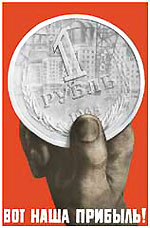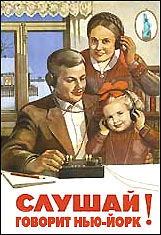RUSSIAN-AMERICAN MARKET NEWS >>>

• The major areas of concentration are NY Tri-State Area, CA, IL, PA, MA.
• The main cities of residence are New York City, Los Angeles, Chicago, San Diego, San Francisco, Seattle and Detroit.
• Russian-Americans have a median annual HH income of $50,500.
• 64% of Russian–Americans are married, with the average number of children 1.6.
• 53% of Russian-Americans hold a bachelor’s degree or higher.
Areas and Percentage of the highest concentration of the Russian-American
population
• NY Tri-State Area – 24%
• California – 16%
• Illinois – 16%
• Pennsylvania – 10%
• Massachusetts – 8%
• Florida – 7%
• DC and Maryland – 3%
Source: US Census Bureau, 1990/2000
* * *
Ethnic Population
The Russian-speaking American market, is characterized by a large, rapidly growing, and well-educated base of US-Russian citizens, permanent and temporary residents who are particularly fond of reading. Although the Mexican-born population is the largest foreign-born segment, the Russian-born population represents the second largest segment at 10.4% of 28.4 million foreign-born Americans and shares various favorable characteristics.
The Russian-born population has a substantially higher per capita income and a higher level of wealth, is better educated, and is older in age, making it a very attractive segment for any health magazine. Combined with an inadequate supply of magazines/ newspapers in the US that capitalize on this market opportunity, the health magazine is well positioned to succeed in attracting extensive readership.
The United States is represented by almost 120 ethnic groups. Seven of these groups—Mexican, Russian, Chinese, Indian, Philippine, Vietnamese, and Cuban —account for more than 55% of the total ethnicities. Two distinct segments represent the ethnic groups:
• descendants of foreign-born Americans who were born in the US, who have completely assimilated into US culture, and for the most part have very little interest in ethnic life, culture, and language;
• foreign-born members of the ethnic groups that in vast majority continue to follow their native traditions, language and culture, and enjoy access to ethnic literature and ethnic sources of information.
The overall market of foreign-born Americans has been documented at 28.4 million as of March 2000, representing 10.4% of the total US population. This market has also grown from 9.6 million in 1970 to 28.4 million in 2000, with an annual compound growth of 3.7%. When compared with 1% annual growth of the overall US population, the foreign-born market represents a sizable and a rather rapidly growing opportunity.
The rapid increase in the foreign-born population between 1970 and 2000 can be largely attributed to the dissolution of communist regimes in Eastern European countries, especially in Russia and the former Soviet Union republics—collectively referred to as "Russia", and to the high level of international migration during the past generation. Accordingly, in 2000, the Russian ethnic group became the second largest ethnic market representing 10.3% or 2.9 million of the American, foreign-born population, topped only by the Mexicans, who claim 28% or 7.8 million foreign-born Americans.
Russian Community in USA
In 2000, the wealth and income averages of the Russian segment were considerably above the averages of the total foreign-born population, with the Russian-born population having plentiful health insurance coverage.
Household
With 1.1 million households for 2.9 million Russian-born Americans, 57% of Russian-born families owned their own home with an average household size of 1.3. Similarly, there were 4.8 million total foreign-born households for 28.4 million foreign-born Americans, reflecting a 41% rate of household ownership with an average household size of 2.44. With more households and less members per household, the Russian-born segment reflects higher wealth.
Employment
The labor force participation in 2000 was from ages 16 and older for the foreign-born population and 23 and older for Russian-born. Further, managerial, professional, technical, sales, and administrative support occupations accounted for 45.6% of foreign-born workers, compared with 67.5% of Russian-born workers. Additionally, higher proportions of foreign-born workers compared with Russian-born workers filled service occupations—31.2% versus 21.4%; worked as operators, fabricators, and laborers— 18.7% versus 11.9%; or held farming, forestry, and fishing jobs—4.6% versus 0.09%. With more focus on post-collegiate work participation and with a higher proportion of the population involved in higher-paying employment, the Russian-born segment also has better income-generating consistency.
Education
In 2000, the proportion of the population aged 25 and older that had completed at least a high school level education was significantly lower among the foreign-born population at 67.0% than among the Russian-born population at 82.3%. The high school completion rate for the foreign-born population was also 67.0% compared with 80.3% for Russian-born population. Additionally, three major Russian book houses are solely dedicated to distribution of books within the US. With a more educated population base, the Russian segment also has a higher inclination toward readership.
Age
As of 2000, although the median ages of the total foreign-born population and the Russian segment did not differ significantly, the age distributions did. The median age of the total foreign-born population was 38.1 years, with the Russian-born segment having a median age of 32.5 years. The overall foreign-born population was also fairly evenly distributed, with 21.0% of the people under 24 years old, with 58.7% being 25 to 54, and with 17.3% being over 55. The age composition of the Russian-born population, however, was substantially more skewed toward the elderly, with 8.6%, 47.6%, and 44.1% in the under 24, 25-54, and over 55 segments respectively. Clearly, the Russian-born segment also has a higher distribution of older population that is more attentive to improved health and medicine for prolonged well-being.
As the second largest foreign-born market segment with 2.9 million people, the Russian-born Americans consume more goods and services, especially within the medical field, have a higher predisposition to reading and to educational media, and are older in age. Additionally, the members of this segment have traditionally chosen to remain employed and interacting within the Russian ethnic community. In a summary, by effectively addressing the Russian-born segment, The Health Magazine can clearly capitalize on a favorable market opportunity.
Income
The median income for households of foreign-born families was $27,300, compared with $36,800 for Russian-born households. Among foreign-born families, the proportion of families with incomes below $25,000 and with incomes of $50,000 or more was 44.5% and 12.2%, respectively. In contrast, only 23.2% of Russian-born families had an income o? less than $25,000, with 27.4% having an income of $50,000 or more. As such, the Russian-born population also clearly represents a higher income segment.
Health Insurance
Only 62.6% of the foreign-born population had health insurance, compared with 84.5% of the Russian-born population (health insurance includes government insurance plans such as Medicare, Medicaid, or military health care and private insurance plans). Among workers, 44.5% of foreign-born and 84.6% of Russian-born had health insurance provided by an employer. Accordingly, the Russian-born segment has a higher purchasing ability for medical and health-related products.
Having more favorable wealth and income parameters, the Russian-born segment has a higher overall purchasing power and is more likely to purchase goods and services. Additionally, having higher health-insurance coverage, the Russian-born population has additional purchasing power allocated to medical products. In summary, advertisements for medical goods and services to the Russian-born segment should generate substantially more responses and more cash flow than advertisements to other ethnic groups.
Source: The HEALTH Russian Magazine
* * *
Notice from MASTER PAGE
According non-official sources (like
Russian-American Media – newspapers, magazines, Russian Internet, radio &
TV) Russian-language population (who lives permanently and temporary in the
USA and Canada) may be estimated in 5-7 million people.
* * *
Info is posted on 07.30.03For more
information
contact to our
English-Russian
speaking
Representative
at (718) 648-3511
or via E-mail: masterpage@inforeklama.com
 RUSSIAN MASS
MEDIA
RUSSIAN MASS
MEDIA
IN NORTH AMERICA
(USA & CANADA):
Russian Newspapers >>>
Russian Magazines >>>
Russian Internet >>>
Russian Yellow Pages >>>
Russian Radio & TV >>>
Russian Outdoor Advertising
>>>